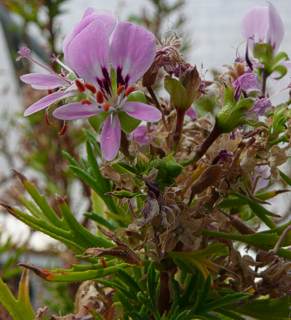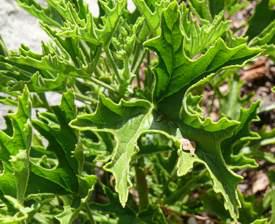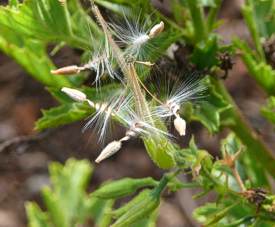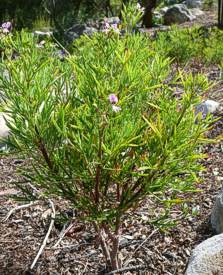Pelargonium scabrum
Pelargonium scabrum (Burm.f.) L'Hér.
Family: Geraniaceae
Common names: rough-leaved pelargonium, three-pointed pelargonium (Eng.); hoenderbos (Afr.)
Introduction
This water-wise, attractive and fragrant shrub makes an interesting garden subject and is ideal for those sunny and slightly drier spots in the garden.

Description
Description
Pelargonium scabrum is an erect, branched shrub, up to 1.2 m, with rough, hairy, 3-lobed leaves. The leaves are lemon-scented and up to 50 mm in diameter. Clusters of white to pink flowers up to 20 mm in diameter are borne from August to January (late winter to summer). The floral tube is 3-12 mm long. The seed is produced in autumn.

Conservation Status
Status
Pelargonium scabrum is not endangered.
Distribution and habitat
Distribution description
Pelargonium scabrum grows on rocky, sandstone slopes, usually in dry habitats. It occurs from Springbok in Namaqualand, along the western coastal region, southwards to Western Cape and to Grahamstown in the Eastern Cape.
Derivation of name and historical aspects
History
The name Pelargonium is derived from the Greek word, pelargos, which means stork. This is due to part of the flower looking like a stork's beak. The genus name, Geranium or Pelargonium was introduced in 1738 by Johannes Burman, a Dutch botanist and physician.
There are ± 200 species of Pelargonium. Often, pelargoniums are incorrectly named Geranium, which is the botanical name for a separate genus also belonging to the family Geraniaceae which is comprised of Pelargonium, Geranium, Erodium, Monsonia and Sarcocaulon. The confusion began when all the Pelargonium species were included in one genus, Geranium. In 1789, they were separated into two genera by Charles L'Héritier who was an 18th century French botanist.
The species name scabrum, is derived from the Latin word, scaber, which means scabrous. This name refers to the leaves and stems which are rough. Pelargonium scabrum was originally named Geranium scabrum by Johannes Burman (1759).
Ecology
Ecology
Pelargonium seed is light in weight and has a feathered tail which is coiled into a spiral. It is adapted to wind dispersal and when it lands on soft soil, the tail causes the seed to twist into the soil thereby anchoring the seed in the ground and preventing it from being blown away. When the rain begins in the autumn, the seed germinates.

Uses
Use
Although Pelargonium scabrum is one of the scented pelargoniums, no cultural uses have been recorded. Horticulturally, this fragrant and attractive shrub is ideal for the drier garden and will do well in a sunny position.

Growing Pelargonium scabrum
Grow
Pelargonium scabrum grows in the winter rainfall region of southern Africa in full sun and well-drained sandy soil. It needs water all year round but less in winter than in summer. It can withstand drought.
Like most pelargoniums, Pelargonium scabrum is easy to propagate from cuttings taken at any time of the year. Take stem cuttings from a healthy, vigorously growing plant. To speed up the rooting process, use a rooting hormone. Place the cuttings in a tray filled with river sand and place the tray in a cold frame or in a cool, slightly shaded area. Keep the tray damp. The cuttings will root within 4 weeks.
Once the cuttings have rooted, pot them into a well-drained, sandy medium and place them in a sunny position. Water the newly potted plants every third day. When they have formed a strong root-ball, plant them into the garden.
Sow seeds in autumn, in a light, well-drained potting mix. Sprinkle the seeds evenly in the seed tray and cover them with fine white sand or fine-milled pine bark. Water the seeds gently but thoroughly with a fine spray and place them in light shade with no direct sun. The seeds will germinate within 2-3 weeks.
References
- Le Roux, A. & Whal, Z. (photographer). 2005. Namaqualand. South African Wild Flower Guide 1, edn 3. Botanical Society of South Africa, Cape Town.
- Manning, J. 2007. Field guide to fynbos. Struik, Cape Town.
- Manning, J. & Goldblatt, P. 1997. Nieuwoudtville, Bokkeveld Plateau and Hantam. South African Wild Flower Guide 9. Botanical Society of South Africa, Cape Town.
- Manning, J. & Goldblatt, P. 2000. Cape plants. A conspectus of the Cape flora of South Africa. Strelitzia 9. National Botanical Institute, Pretoria.
- Van der Walt, J.J.A. 1977. Pelargoniums of southern Africa. Purnell, Cape Town.
- Van Rooyen, G. & Steyn, H. 1999. Cederberg, Clanwilliam and Biedouw Valley. South African Wild Flower Guide 10. Botanical Society of South Africa, Cape Town.
- website: http://en.wikipedia.org/wiki/Pelargonium
- website: http://en.wikipedia.org/wiki/Johannes_Burman
- website: http://www.plantzafrica.com/plantnop/pelargcitro.htm
Credits
Karen Wall
Kirstenbosch National Botanical Garden
March 2009
Plant Attributes:
Plant Type: Shrub
SA Distribution: Eastern Cape, Northern Cape, Western Cape
Soil type: Sandy, Loam
Flowering season: Spring, Early Summer, Winter
PH: Acid, Neutral
Flower colour: Purple, White, Mauve/Lilac
Aspect:
Gardening skill:
Special Features:
Horticultural zones











Rate this article
Article well written and informative
Rate this plant
Is this an interesting plant?
Login to add your Comment
Back to topNot registered yet? Click here to register.